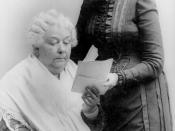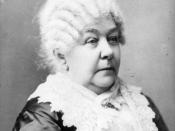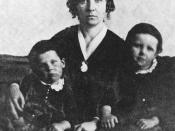Life for the American woman in the 19th century was full of conflicts and struggles. Women suffered from a lot of discrimination, and were not allowed to vote, attend universities, speak in public, or own property, and were essentially forced to fight for their place within society. Regardless of these difficulties, women gathered strength in numbers and succeeded in establishing permanent social changes.
Susan B. Anthony and Elizabeth Cady Stanton began to work together on women's rights and one of the first issues they worked on were property rights for married women. The Married Woman's Property Act had been passed in New York Stat in 1848. However, there were still gross inequities for married women under the law. A married woman could not sell her property or own the wages she had earned. The lack of legal status for married women was an ongoing issue for the early women's rights movement.
If women could not enter into contracts, it was unlikely that they could ever win such a right as suffrage. The first major struggle for women's rights after the Seneca Falls convention was petitioning for married women's property rights. The fight against unfair treatment under the law became a rallying point for Stanton and Anthony.
Writing was a popular form of expression for women and was used as tools of social change--in the form of letters, essays, magazine and newspaper articles, short stories and books. These works became the beginning of intellectual expression through which women not only battled for their own rights, but paralleled their situation to that of the enslaved black man as well, and fought for the abolition of slavery. Women then took one step further when in 1843 Margaret Fuller backed up a declaration and expanded it in her article The Great Lawsuit which...


